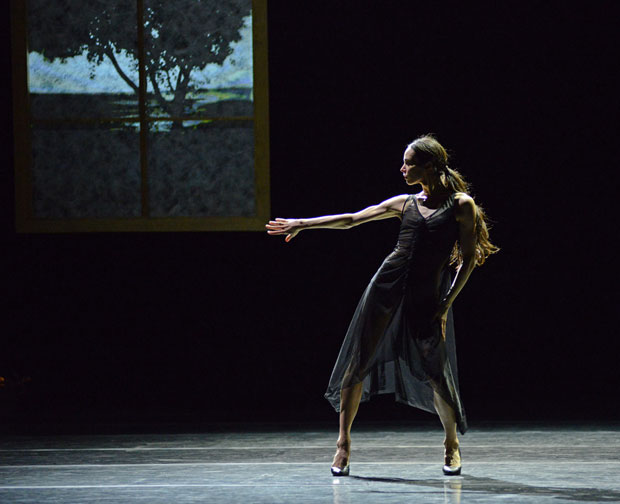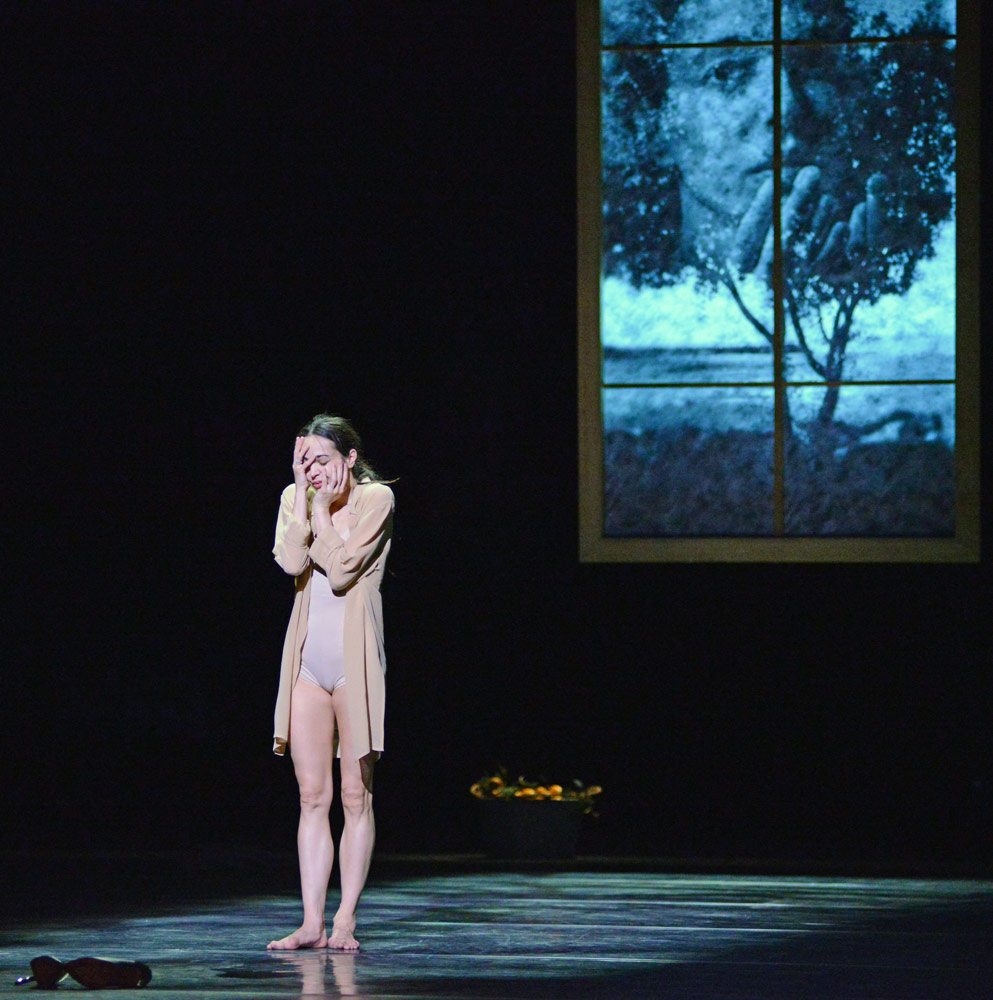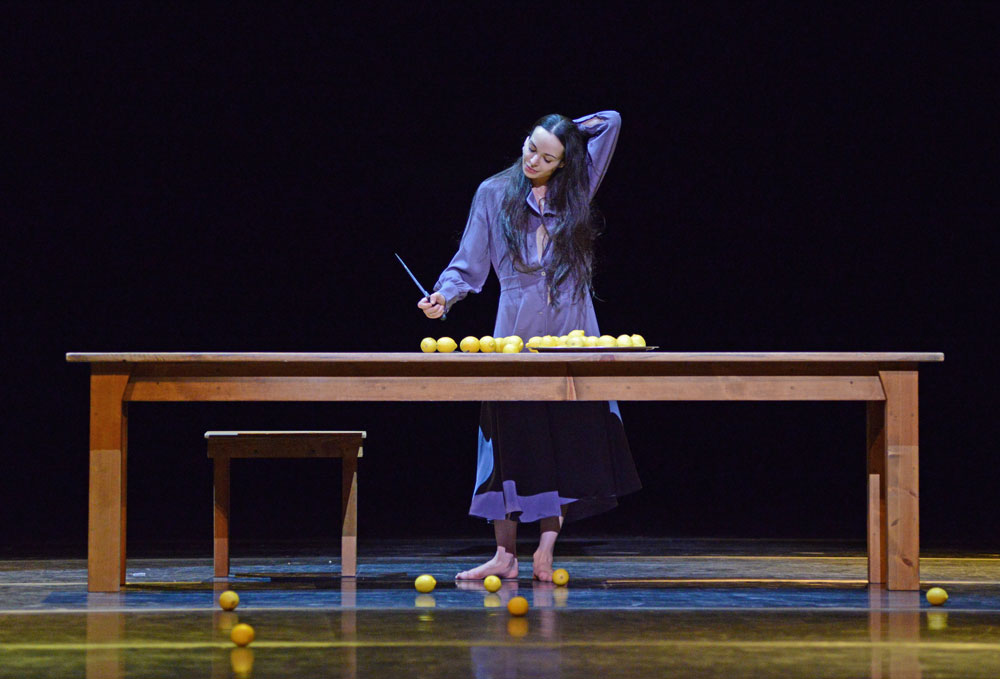
© Dave Morgan. (Click image for larger version)
Diana Vishneva
On the Edge:Switch, Woman in a Room
London, Coliseum
14 April 2015
Gallery of pictures by Dave Morgan
www.vishneva.ru
Diana Vishneva, 39 year old principal dancer with the Mariinsky and American Ballet Theatre companies, is better known in the United States than she is here. We are still in thrall to Sylvie Guillem, captivated by her intelligent choice of choreographers for her post-ballet career. Vishneva is finding her way (as is Wendy Whelan, ex-New York City Ballet), challenging established choreographers to make the most of her talents as a dancer and actress.
For On the Edge, her third showcase, Vishneva commissioned two long pieces, one by Jean-Christophe Maillot, director of Les Ballets de Monte Carlo (whose company is to appear at the Coliseum later this month), and Carolyn Carlson, whose long career as performer and choreographer has been spent in Europe rather than her native America. The double bill was first performed in Monaco and California in 2013.

© Dave Morgan. (Click image for larger version)
The evening opens with Maillot’s Switch, to a collage of music by Danny Elfman, composer of the Edward Scissorhands film and Matthew Bourne danceical of the same name. Switch is a trio, involving two veteran former dancers from Maillot’s company, Bernice Coppieters and Gaetan Morlotti, as foils to Vishneva’s demanding diva. The setting is a fashionable apartment that also serves as dance studio, with a movable barre for the star ballerina.
Vishneva swans in imperiously, dressed in silver lamé by Karl Lagerfeld. She treats Morlotti with contempt, dropping her bag for him to pick up. But she’s evidently fragile, teetering on pointe with a twitch in one forearm. Though she appears to be indulged by her two acolytes, she is at their mercy. The sinister ménage à trois is reminiscent of The Servant and The Lesson, with the two assistants conniving in a power play with their employer. When Vishneva turns vamp, swirling her hips against Morlotti while Coppieters watches, there are obvious echoes of Miss Julie.

© Dave Morgan. (Click image for larger version)
Alliances shift all the time, with Coppieters, bleached blonde hair in a gamine crop, the most intriguing character of the three, devious and compelling. She and bald-headed Morlotti prowl around voraciously, while Vishneva gets the show-off steps, a parody of an old-fashioned Mariinsky ballerina until she strips to her black leotard for the finale. Arching her sinewy limbs in balletic stretches, she is in servitude to the barre, a lonely practitioner of her art with a body bound to betray her as she ages. In the background, her uncaring assistants make love. In a last switch to the convoluted story, Vishneva’s prima accepts the inevitable: removing her pointe shoes and tying them to the barre, she kisses her hand in farewell to her audience.
Where Maillot treats Vishneva as the star of a cinematic melodrama, Carlson sets out to reveal her as a woman undergoing a 40-minute journey of reflection. Apparently inspired by the films and poetry of Andrei Tarkovsky, Woman in a Room depicts the dancer coming to terms with her memories and herself with the aid of a lot of lemons. Alone in a room with a view of a tree through a window, Vishneva starts out in distress and ends in happy resignation. She is accompanied by the cello-based compositions of Giovanni Sollima until the up-beat conclusion to René Aubry’s Plaisirs d’amour.

© Dave Morgan. (Click image for larger version)
Carlson designed the spare set of a stool and long table along which Vishneva frets and flails. She hangs on to it, feet pedalling furiously, slumps against it, head on hands, howling silently. Her voice is heard briefly on tape, muttering in Russian (possibly Tarkovsky’s poem Eurydice, printed in the programme). Every physical cliché is resorted to, as Vishneva clutches her heart and her womb, contracts her abdomen, flings herself backwards in agony, then caresses her arms and skips in merry recollections.
She abandons her long coat and skimpy blue petticoat for a black dress and high heels. The sight of lemons on the table cheer her up into a kind of folk dance until she languishes again in bare feet, a flesh-coloured leotard and diaphanous coat, plunging in deep arabesques and backbends. She’s undergoing a metamorphosis, a journey of the soul. She sees videoed images of her face in the leaves of the tree outside the window, no doubt reflecting her varied personalities as a woman and artist.

© Dave Morgan. (Click image for larger version)
Smiling, she puts on the black dress and heels, chops up the lemons into quarters and climbs down into the auditorium to offer them to audience members in the front stalls. According to Carlson’s programme note, the lemons represent segments of challenge and confrontation, the ceremony of offerings a forging of chaos into harmony and inner freedom. In interviews, Vishneva has said she greatly valued the experience of discovering aspects of herself through her collaboration with Carlson (and two other credited choreographers, Sara Orselli and Henri Mayet). If you accept the solo as a soul-cleansing ritual, you will be moved by Vishneva’s transformation from tortured contemporary dancer into generous fruit-giver. Otherwise it’s a load of pretentious cobblers, ending with an audience-ingratiating device appropriated from Pina Bausch’s pieces. Vishneva, a splendid performer, has questionable taste in the choreographers she commissions.

















You must be logged in to post a comment.